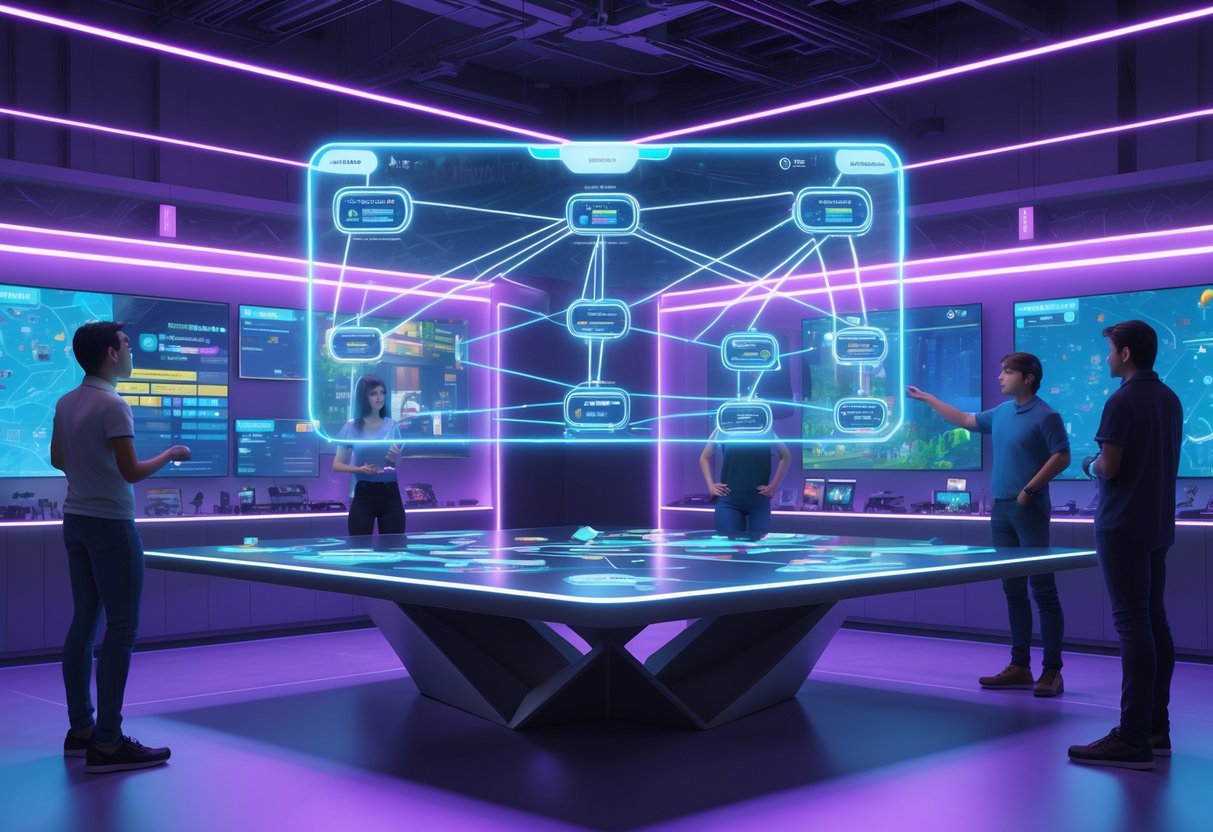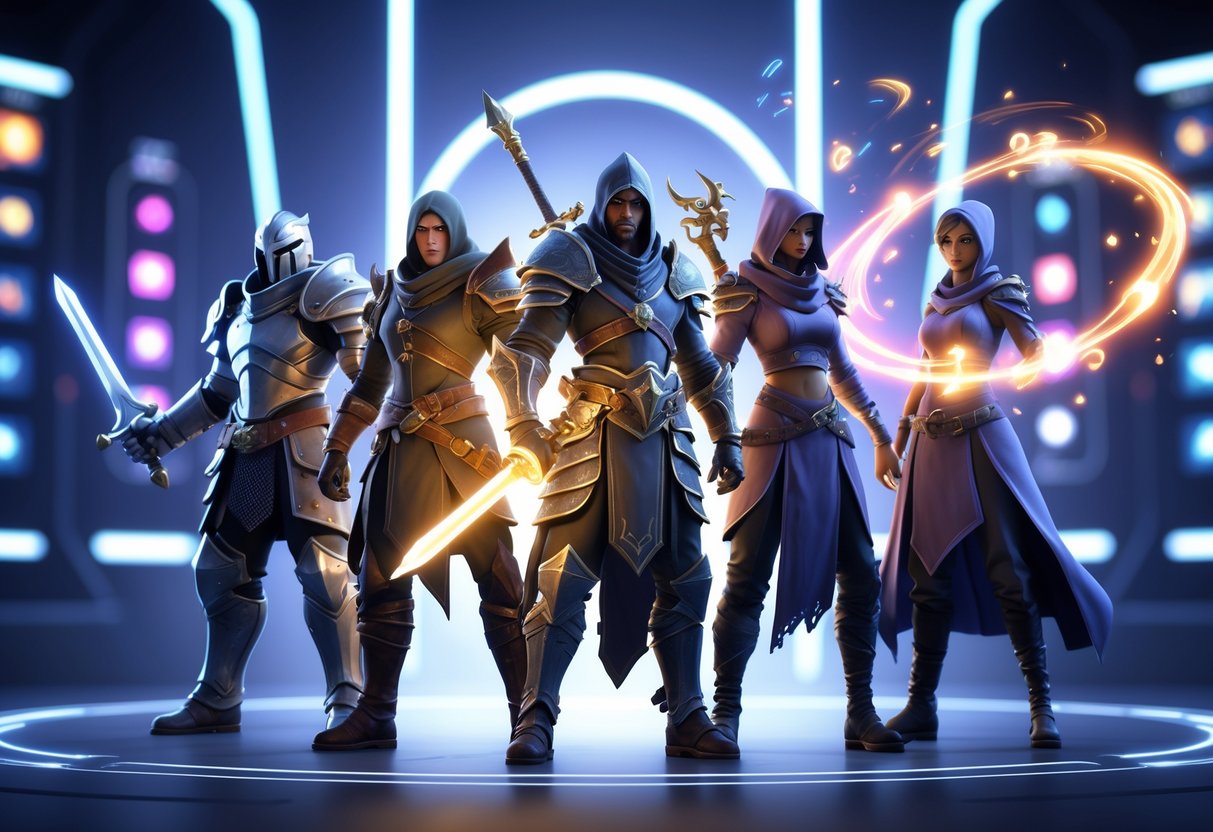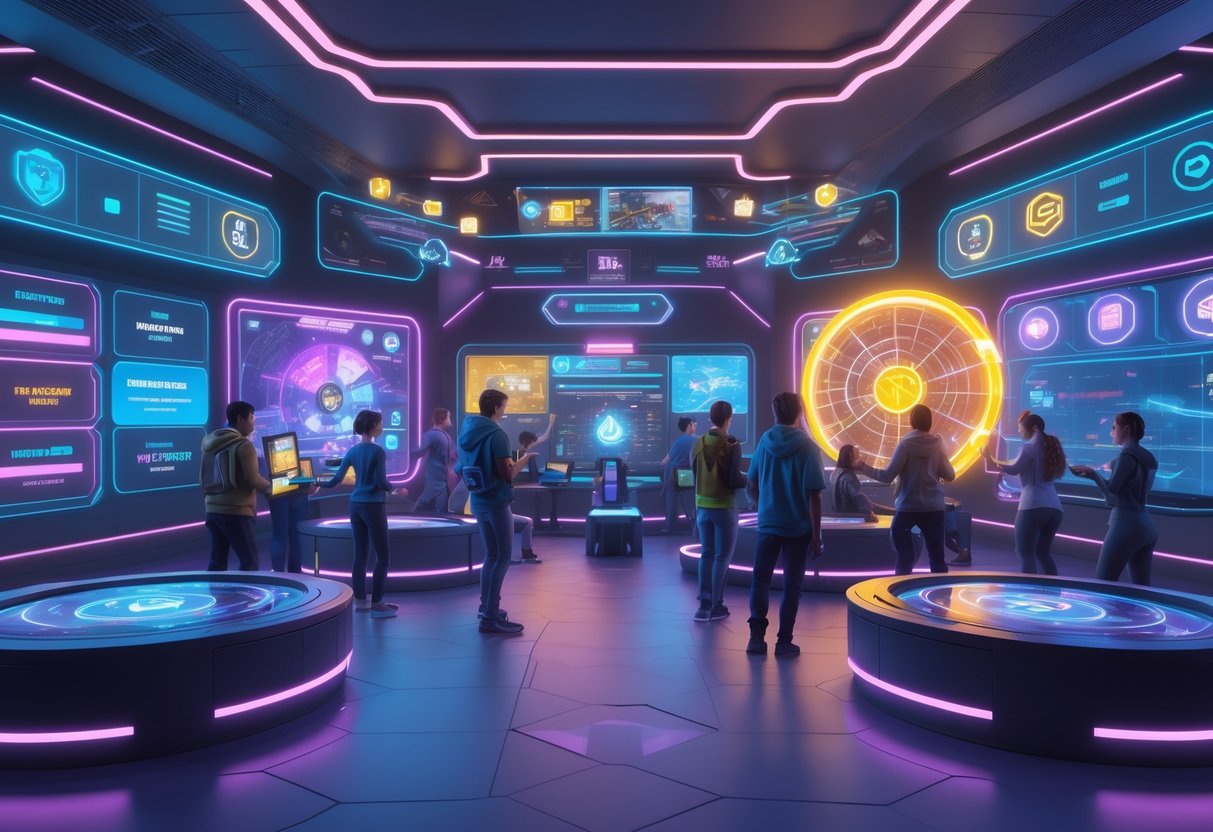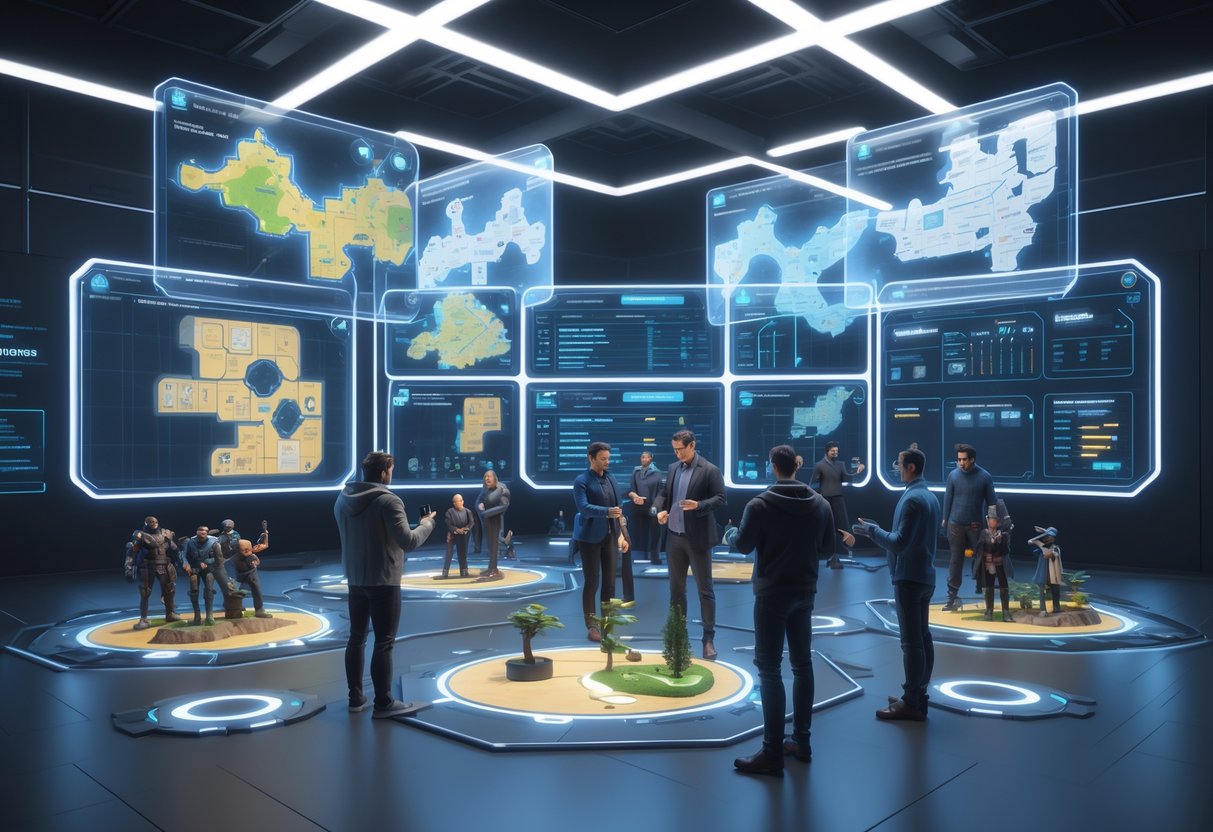Replay Value Enhancement: Key Strategies and Game Design Insights
Updated On: October 26, 2025 by Aaron Connolly
Core Concepts of Replay Value
Replay value shows how much a game pulls players back after they’ve finished it. When developers understand what brings people back, they can craft experiences that stay lively for years.
Definition and Importance
Replay value basically means a game keeps you interested through multiple playthroughs. Some folks find themselves returning weeks, months, or even years after that first run.
In the world of competitive games, strong replay value builds lasting communities. Look at Counter-Strike—its player base has stuck around for decades because every match feels fresh. That kind of staying power helps games thrive in esports.
Key benefits:
- Longer game lifespan
- Stronger communities
- More word-of-mouth buzz
- Better player retention rates
When a game has good replay value, people feel like their money was well spent. Getting 100+ hours from one purchase? That usually leads to glowing reviews and plenty of recommendations.
Player Motivation Factors
Players come back to games for all sorts of reasons. Figuring out what drives them helps explain why some games stick around and others just disappear.
Mastery and skill development draw in a lot of folks. Fighting games like Street Fighter reward endless practice. Players return to sharpen their skills and climb those ranks.
Social connections keep people logging in. Sometimes, the main reason to play is hanging out with friends or keeping up with a guild. Often, the social side outlasts the core gameplay itself.
Collection and completion attract the completionists. Unlocking every character, hunting for secrets, or chasing platinum trophies gives players a reason to dive back in.
Varied experiences—like randomization or meaningful choices—make each run feel different. When maps, loot, or storylines shift based on your decisions, no two playthroughs end up the same.
Types of Replay Value
You can break replay value down into three types, based on what changes each time you play.
Mechanical replay value comes from gameplay variety. Roguelikes generate new levels every run. Strategy games let you try different factions. Racing games mix things up with tracks and cars.
Narrative replay value focuses on the story. Multiple endings nudge you to try new choices. Hidden story bits reward players who dig deep. Some games even show events from different characters’ perspectives.
Social replay value springs from multiplayer. Every match against real people is a new challenge. Teaming up with different players or facing off in ranked matches keeps things interesting.
The best games usually blend these types together. Dark Souls, for example, gives you mechanical depth through character builds, sneaky narrative secrets, and online interactions that create spontaneous social moments.
Game Design Principles for Extended Replayability

Building replayability takes planning right from the start. You need a careful balance between challenge and reward, plus lots of testing with real players.
These principles help developers keep their games appealing across multiple playthroughs.
Integrating Replay Value During Game Development
If you want replayability, plan for it from day one. Tacking it on at the end rarely works out.
Start with core systems that support variety. Build your main gameplay loops so players can try different choices and strategies. Flexible mechanics let people experiment instead of forcing a single path.
Developers should focus on emergent gameplay early. These systems create unexpected combos and outcomes. When players stumble onto new strategies, they want to keep exploring.
Foundational elements to consider:
- Multiple character builds or playstyles
- Branching stories with real consequences
- Randomized elements that mix things up
- Modular levels that don’t get stale
Make replay value part of the game’s DNA. Integrate these systems into the main design doc, not as afterthoughts.
Dynamic environments really boost replayability. Worlds that react to your actions and change over time give you new stuff to discover with each run.
Balancing Challenge and Enjoyment
Getting difficulty right matters a lot for replayability. If it’s too easy, people get bored. Too hard, and they’ll just quit.
We build adaptive difficulty systems that shift based on player skill. Sometimes that means offering multiple modes, or letting mechanics scale with your performance.
The sweet spot:
- Clear skill progression that feels good
- Challenges that force you to try new tactics
- Optional tough content for veterans
- Real rewards for overcoming tough spots
Skip artificial difficulty—no one likes bullet sponges or cheap tricks. Instead, make things interesting with meaningful choices and strategic depth.
Layered challenges work well. Casual players enjoy the basics, while hardcore fans can go deep with advanced strategies.
We test difficulty with lots of different players. What feels right to the dev team usually needs tweaks for everyone else.
Player choice is huge. Give people options for tackling challenges. When one approach fails, they should have other ways to move forward.
Playtesting for Replayability
Testing replay value needs a different approach than regular playtesting. We look for long-term engagement, not just first impressions.
Run extended sessions with the same players over a few weeks. Watch how they change as they get used to your systems.
Track stuff like:
- How many players start a second playthrough
- Where people tend to drop off
- Which features keep players hooked
- What new strategies players come up with
Focus groups help collect feedback on replay motivation. Ask directly—what would make you play again? What’s stopping you now?
Test with different types of players. Casual and hardcore gamers often want totally different things from replay systems.
Iterate based on what people actually do, not just what they say. Sometimes players ask for features they barely use.
Test randomization thoroughly. Random elements should stay interesting without feeling unfair or breaking the game.
Keep an eye out for emergent strategies. Players often invent the coolest replay hooks, even if you didn’t plan for them.
Gameplay Mechanics that Encourage Multiple Playthroughs
Clever game design uses certain mechanics to keep players coming back for more. These systems shake up the experience each time, so every run feels new.
Difficulty Settings and Modifiers
Difficulty modes have come a long way. Modern games often use adaptive difficulty that unlocks new stuff, not just tougher enemies.
New Game Plus is a classic replay mechanic. You keep your progress but face new challenges. Maybe you hold onto your gear but enemies get tougher, or you unlock new story routes you couldn’t see the first time.
A lot of games now offer detailed difficulty modifiers so you can tweak things:
- Enemy aggression
- How scarce resources are
- Puzzle difficulty
- Time limits
Unlockable difficulty tiers give you a reason to replay. Beat the game once and you unlock “Nightmare Mode” with new bosses or storylines. That way, finishing the game opens up even more content.
Some games flip the script with inverse difficulty curves—mastering advanced mechanics actually makes future runs more interesting, not just easier. That keeps things fresh for veterans without scaring off new players.
Dynamic and Procedurally Generated Elements
Procedural generation is a goldmine for replay value. It mixes up core elements every run, not just the map but also story events, characters, and missions.
Roguelike mechanics are the poster child here. Every death sends you back with upgrades, but enemy placements, loot, and hazards all get shuffled. The basics stay familiar, but the details change every time.
Dynamic event systems keep things unpredictable. Random encounters, changing weather, and shifting NPC behavior create moments you can’t repeat.
Procedural narrative branching means algorithms tailor the story to your choices and playstyle. On your second run, you might see totally different character arcs or plot twists.
Seasonal content rotation keeps online games lively. Limited-time events, new maps, and fresh modes make regular players eager to come back.
Adaptive AI and Responsive Systems
Learning AI systems watch how you play and shift enemy tactics. If you love stealth, guards get sharper. If you go in guns blazing, enemies might start working together.
Responsive difficulty scaling keeps an eye on how you’re doing and tweaks the challenge as you go. It helps avoid both frustration and boredom.
Dynamic faction systems remember your choices. If you made certain alliances last run, different groups might treat you differently next time.
Emergent gameplay mechanics pop up when complex systems interact. Physics, AI, and the environment combine to create surprises that feel real, not scripted.
Player-driven ecosystem changes mean your actions actually reshape the world. Maybe defeating a boss changes enemy spawns or unlocks new areas in future runs.
New Game Plus: Concept and Implementation
New Game Plus lets you restart a finished game while keeping some progress—like weapons, levels, or abilities. Usually, you get exclusive unlocks and tougher challenges that push your skills further.
Unlockables Exclusive to Subsequent Playthroughs
Exclusive rewards really drive solid New Game Plus systems. Tangible incentives make replaying more than just a nostalgia trip.
Some games save their best gear for second runs. Resident Evil 4 gives you infinite ammo weapons only after you beat it. Suddenly, those early levels become a breeze.
Story content often hides behind New Game Plus. Persona 5 Royal locks whole character arcs until your second playthrough. You get new dialogue and options that call back to your previous choices.
Other games hand out cosmetic rewards. Skins, costumes, or visual tweaks let you show off for sticking with it. They don’t change gameplay, but they’re fun to collect.
Pro tip: If a game promises “multiple endings,” odds are the best stuff is tucked away in New Game Plus.
Progressive Difficulty Scaling
Smart scaling keeps you from steamrolling repeat playthroughs. The best systems match the challenge to your powered-up character.
The Witcher 3 makes sure enemies scale with Geralt’s imported stats. Suddenly, those wolves at the start are scary again. Resources get tighter, so you can’t just coast.
Adaptive enemy behavior shows up in games like Dark Souls. Enemies get new attacks or become more aggressive in later cycles.
Some games add mechanical restrictions to keep things tough. Maybe health comes back slower or items aren’t as effective. You can’t just rely on the same old tricks.
Heads up: If scaling isn’t balanced well, New Game Plus can go from fun to annoying fast—always check reviews for comments about difficulty.
Achievements and In-Game Rewards
Smart achievements set clear goals that make players want to come back, even after the main story wraps up. Hidden collectibles and multiple endings encourage you to explore every nook and replay sections with a new perspective.
Achievement Systems and Player Motivation
Well-designed achievement systems grab us because they tap into our natural urge to finish tasks and see our progress. The best achievements don’t just hand out rewards for playing as usual.
Challenge achievements make us step up our game or get creative. Beating a tough level without taking a single hit? That really forces us to master the mechanics. Speedrun achievements? They push us to find shortcuts and get our timing just right.
Discovery achievements reward exploration and curiosity. Stumbling across secret areas or rare items feels genuinely clever. Open-world games shine here, since it’s easy to miss cool stuff on your first run.
Progress achievements track those long-haul goals, like defeating 1000 enemies or grabbing every weapon. They keep us interested during slow stretches and give a little satisfaction as the numbers climb.
Rewards matter, too. Unlocking new character skins, weapons, or game modes? That’s a real incentive. Cosmetic bonuses let us show off to other players in multiplayer—always a nice touch.
Secrets, Collectibles, and Alternate Endings
Hidden content turns single-playthrough games into treasure hunts. Developers love to scatter secrets all over their worlds for us to find.
Collectibles actually work best when they mean something, not just busywork. Audio logs that flesh out the story, or concept art that shows a bit of the development process, add real value. If each collectible teaches us something new, we’re way more motivated to hunt them all down.
Secret areas deliver those memorable “aha!” moments. Finding a hidden room behind a fake wall or unlocking a special level with a weird button combo makes us feel like we’ve really discovered something.
Multiple endings give our choices actual weight. Games like Undertale totally change depending on how we treat other characters. We end up replaying just to see how different decisions shake out.
Smart developers sometimes lock content behind achievement requirements. Unlocking a secret character after finishing a tough challenge gives us a clear goal. Achievements end up guiding us to hidden content, which in turn opens up new ways to rack up even more achievements.
Narrative Structure and Branching Storylines

Games that let us shape the story through our decisions create multiple narrative paths. Each choice leads somewhere new, tempting us to see every possible route.
Impact of Player Choices
Our decisions can totally change how stories play out in games with branching narratives. When we choose something, the game remembers and tweaks future events.
These choices create meaningful consequences. Sparing an enemy might mean they help us later. Exploring a risky area could unlock new storylines, but maybe at the cost of a teammate.
The emotional weight behind these choices keeps us coming back. Ever wonder “what if” you’d picked differently at a crucial moment?
Games like Mass Effect and The Witcher really nail this. Every big decision sends out ripples, changing relationships and the story’s direction.
Quick win: Try games that clearly show choice consequences with dialogue trees or visual cues.
Multiple Endings and Narrative Paths
Branching narratives give us several endings, all based on choices we’ve made. It works a bit like a tree—one main story trunk, lots of branches leading to unique conclusions.
Each path reveals different character backstories and plot points. Some focus on romance, others on combat or political drama.
The variety makes us want to replay. Naturally, we get curious about how things could play out differently.
Common narrative structures:
- Binary branches: Two clear routes at major points
- Multiple outcomes: Three or more choices with real consequences
- Weighted decisions: Some choices matter way more than others
Games track our decisions through save files or profiles, so the story can reference what we did—even much later.
Heads up: Some games pretend to offer choices, but nothing really changes. That kills replay value fast.
Character Classes and Customisation Options

Character classes and customisation systems let us tackle the same game in fresh ways. Unique builds and playstyles make each run feel new.
Multiple Character Classes
Different character classes completely change your experience. A sneaky rogue plays nothing like a tank or a spell-flinging mage.
Each class comes with its own set of abilities and strategies. Rogues sneak around and strike from the shadows. Warriors charge in, decked out in heavy armor.
Class variety makes us want to experiment. Most of us finish the game once as our favorite class, then get curious and try something else.
Some games cram too many mechanics into classes, making them too rigid. The best systems balance a strong class identity with plenty of player choice.
| Class Type | Typical Playstyle | Replay Factor |
|---|---|---|
| DPS | High damage, fragile | High |
| Tank | Absorbs damage | Medium |
| Support | Helps teammates | High |
| Hybrid | Mix of abilities | Very High |
Caution: If classes only feel a little different, replay value doesn’t really go up. They need to play genuinely differently.
Character Development Across Playthroughs
Customisation lets us build unique characters, even within the same class. Two warriors can feel worlds apart.
Visual customisation counts, too. Creating a character that looks unique makes us more likely to dive into another playthrough.
Skill trees and upgrade paths add another layer. One mage focuses on fire, another on ice—the experience changes a lot.
The best systems mix visual and gameplay customisation. We want to look unique and play differently.
Quick win: Go for games that let you save different builds. It’s way easier to try new combos without losing progress.
Customisation only works if choices actually matter. If it’s all surface-level, it won’t drive replays. We need to feel a real difference in how our character plays.
Alternative Game Modes and Post-Game Content

Finishing a game’s main story doesn’t have to mean the end. Alternative modes and ongoing content updates keep us coming back, sometimes for years. These features let us keep playing without just repeating the same old story.
Endless and Mercenary Modes
Endless modes ditch the finish line. We keep playing as challenges ramp up or shift in new ways.
Survival modes throw tougher enemies at us wave after wave. Fighting games often have arcade towers that just keep going.
Mercenary modes mix up the gameplay entirely. The Resident Evil series really nailed this with time-attack challenges and score-based missions.
These modes usually have:
- Different goals than the main story
- Leaderboards for competition
- Unique rewards like costumes or weapons
- Shorter sessions for quick play
Quick tip: If you loved a game’s combat, check out mercenary modes for a fresh challenge.
The big draw is variety. We use familiar mechanics in new ways, skipping the story we already know by heart.
DLC and Regular Content Updates
Downloadable content (DLC) adds big chunks of new stuff—areas, characters, even whole storylines. Good DLC can double the time we spend with a game.
Premium DLC usually runs £10-30 and brings new campaigns or big features. Free updates might just tweak things or add seasonal events.
Live service games get regular updates for years. They stick around thanks to:
- Monthly content drops
- Seasonal battle passes
- Community events
- Balance tweaks based on feedback
Heads up: Some games lean too hard on DLC and feel unfinished at launch.
Regular updates keep the community buzzing. We log back in knowing there’s always something new to try.
The sweet spot? Paid expansions with real substance, plus free updates that make life better for everyone.
Successful Examples of Replay Value Enhancement

Big-name games have figured out how to keep us hooked for hundreds of hours. If you look at what they do, you’ll spot strategies that work across genres and for all types of players.
Case Studies from Notable Titles
The Witcher 3: Wild Hunt shows how meaningful choices drive replay value. Every decision shifts relationships and storylines. Plenty of us replay just to chase different romance options or see all the endings.
The game tracks over 36 possible world states, all based on our choices. Each run genuinely feels different.
Dark Souls hooks us with challenging gameplay and hidden secrets. New Game Plus mode cranks up the difficulty but lets us keep our gear, creating a risk-reward loop that’s hard to resist.
With multiple weapon classes and builds, each playthrough feels fresh based on how we develop our character.
Diablo 3 thrives on procedurally generated levels and wild loot systems. No two dungeon runs play out the same. Seven character classes, all with unique abilities, keep things interesting.
| Game | Key Replay Features | Average Playtime |
|---|---|---|
| The Witcher 3 | Branching narrative, multiple endings | 100+ hours |
| Dark Souls | New Game Plus, varied builds | 80+ hours |
| Diablo 3 | Random levels, character classes | 200+ hours |
Lessons from Industry Leaders
Gaming expert James Connolly says the secret to replay value is player agency and meaningful variation. The best games avoid randomness that just feels pointless.
Variety should have a reason. Games like Civilization VI nail it because every run teaches us something new. Random events tie back to our decisions, not just chaos for chaos’ sake.
Progressive difficulty beats artificial walls. We stick around when we feel ourselves improving, not just grinding. Good games reward skill, not just time.
Player choice needs real consequences. If customisation is just skin-deep, it won’t keep us coming back. The best games actually change mechanics or story outcomes based on what we do.
Industry leaders focus on quality, not just quantity. Three deep story paths beat ten shallow ones every time. Players know when content is genuine and when it’s just filler.
Common Pitfalls in Designing for Replayability

A lot of developers fall into two big traps when building replay value. They overuse random elements, or they bolt on systems that don’t really work together.
Overuse of Randomness
Random content isn’t automatically good replay value. Honestly, we see this mistake all the time.
The Random Trap Just shuffling things around doesn’t give us real variety. We spot it pretty quickly when randomness has no real substance.
Take survival games that randomize resources. Sure, iron ore spawns in new spots, but you’re still mining iron ore the same way.
Surface-Level Changes A lot of games randomize looks or layouts but leave the actual gameplay unchanged. A new enemy color or a shuffled room doesn’t change how you play.
Key Warning Signs:
- Randomness with zero gameplay impact
- Procedural generation that gets old after a couple runs
- RNG that replaces skill or strategy
- Variance that doesn’t affect our decisions
Better Approaches Aim randomness at things that force us to play differently. The Binding of Isaac works because different item combos make us adapt every run.
Random events should create new challenges, not just slap a fresh coat of paint on the same old stuff.
Lack of Coherent Integration
The biggest replay value killer pops up when game systems just don’t interact the way you’d hope. People call this the “feature soup” problem, and honestly, it fits.
Disconnected Systems
When developers add replay features but don’t actually connect them, the result is just confusion. Random loot, branching paths, and character progression should build off each other, not just float around separately.
Example Problems:
- Skill trees ignore randomly generated content
- Story choices don’t touch gameplay mechanics
- Progression systems pull players in different directions
The Integration Test
So, here’s a quick check: when you change one system, do the others respond? If your character build never affects how you tackle procedurally generated levels, something’s off.
Real Consequences
Players get overwhelmed by choices that don’t connect. Instead of feeling excited to replay, they just freeze up and end up not wanting to choose at all.
Solution Framework
It’s better to design fewer, more deeply connected systems. Every replay element should boost the others, so variety multiplies instead of getting diluted.
Future Trends in Replay Value Enhancement

Gaming tech keeps moving fast, and developers keep finding new ways to hook players for the long haul. AI-driven personalization and cross-platform features are really shaking up how replay value gets built in.
Emerging Technologies and Techniques
AI-driven personalization is changing the game, literally. Modern games track how you play and tweak difficulty, storylines, and even content to match.
Each playthrough can feel genuinely new. The game figures out if you like sneaking around or just charging in, or maybe you’re all about exploring.
Machine learning algorithms watch how players behave. They predict what’ll keep each person interested longer.
Cross-platform play has blown up multiplayer communities. You can compete with friends, no matter what device they’re on.
Procedural generation tech has gotten so much better. Games like No Man’s Sky build nearly endless, unique worlds with fancy algorithms.
Blockchain tech brings new options for player-owned content. Now, you can actually own and trade in-game stuff across different games.
Cloud gaming services make it super easy to jump into huge libraries. It’s less hassle to try something new, so people explore more.
Evolving Player Expectations
Players now expect immediate value when they buy a game. They want progression systems that respect their time, not waste it.
Personalized touches aren’t just a nice bonus anymore. Players expect games to remember their choices and adapt.
Community-created content keeps people coming back. Players want tools to make, share, and even sell their own stuff.
Content updates need to drop regularly. Seasonal events, new characters, fresh challenges—players just expect them now.
Transparent progression systems really matter. People want to see a clear path to new content, without endless grinding.
Social features should just work. Players want to share achievements, compete, and build little communities inside their games.
Cross-generational play is a bigger deal now. Families want games that both parents and kids can play together, side by side.
Frequently Asked Questions

Game developers keep asking what actually works to keep players coming back. Here are some questions about what really creates lasting engagement and replay value.
How can I increase the longevity of my game for players?
Lean into rogue-like mechanics that make every run feel fresh. Players fail, sure, but they unlock new skills and stats that help them get further next time.
Offer character classes with real differences in playstyle. The bigger the gap between classes, the more reasons players have to start over.
Unlock tougher difficulty settings after players finish the game. Higher difficulties can reward players with extra cutscenes or endings they couldn’t see before.
Keep the game updated. Even games you buy once can stay alive if you drop new content every so often.
What are some effective methods to encourage players to replay our game?
Build multiple story routes with different endings based on what players choose. That way, a second playthrough feels like a whole new story.
Add a New Game Plus mode with exclusive content. Let players unlock new areas, weapons, or even alternate final bosses they couldn’t get to the first time.
Put in collectables and achievements that need more than one run to complete. Steam achievements in particular can really drive completionists to come back.
Give players unlockables that actually change the game. Costumes, new abilities, or carrying over progress from old runs all add motivation.
In what ways can additional content contribute to a game’s replayability?
Post-game content lets players keep going after the main story. Think about Pokemon’s endgame areas or Path of Exile’s mapping system that unlocks after finishing.
Alternative game modes keep things interesting. Resident Evil’s Mercenary modes, for example, use the same maps but totally different goals.
DLC and expansions pull players back, sometimes months or years later. This works best when the base game already has strong replay value.
Endless modes skip the finish line altogether. Players can just jump in for a quick session without having to commit to a full run.
Could you suggest strategies to keep players engaged with our game for longer periods?
Build progression systems that work across multiple playthroughs. Players should feel like they’re making progress toward big goals, even when starting from scratch.
Shake up the core gameplay loop. Games like Football Manager and RimWorld succeed because every new save throws different challenges at you.
Let player choices matter for future runs. When decisions have lasting effects, people want to see what happens if they pick a different path.
Design for brains, not just reflexes. Games that reward planning and strategy usually have more replay value than those that only test your reaction time.
What role do alternate endings play in enhancing a game’s replay appeal?
Alternate endings give players a real reason to replay right after finishing. They want to see what happens if they make different big decisions.
Branch endings based on meaningful choices throughout the game. Just changing a few lines of dialogue won’t cut it—major story beats need to shift.
Lock certain endings behind special requirements or higher difficulties. Players will come back to meet those challenges and unlock what they missed.
Make endings different enough to feel like new experiences. Swapping out a cutscene isn’t enough; players want truly distinct finales.
How can community-driven content be leveraged to boost a game’s replay value?
Let players use modding tools or level editors to make their own content. When your community creates fresh experiences, your game sticks around way longer than you could manage solo.
Encourage competitive communities to grow around your game. Stuff like leaderboards, tournaments, or seasonal challenges keeps people coming back for more and always chasing that next win.
Add sharing systems so players can show off their achievements or crazy runs. When someone gets to brag about what they’ve done, you can bet they’ll want to take on tougher challenges just for the bragging rights.
Let community feedback actually shape future updates. If players notice their ideas show up in new content, they’ll care more and keep coming back.

